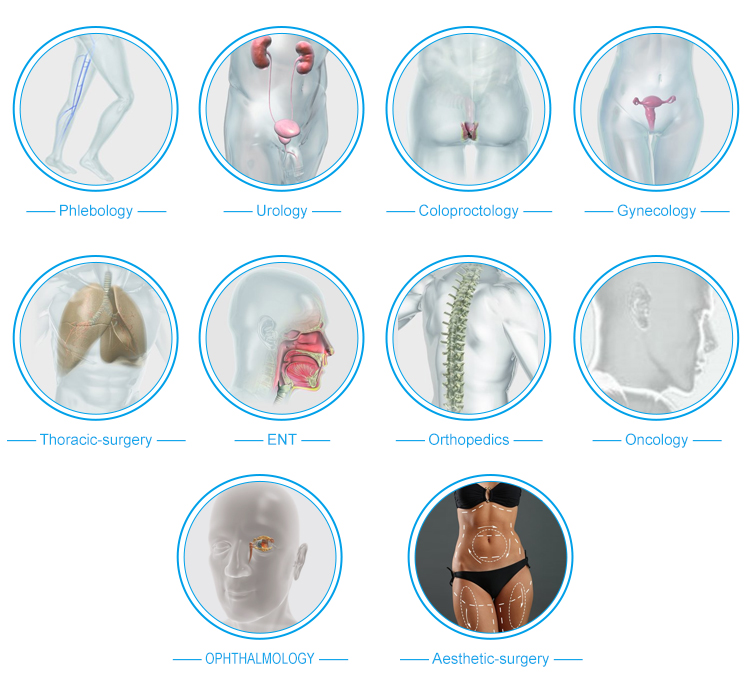Our diode laser 980nm+1470nm can delivery of laser light to soft tissueinthe contact and non contact mode during surgical procedures. The device’s 980nmlaser is generally indicated for use in incision, excision,vaporization, ablation, hemostasis or coagulation of soft tissue in ear, nose and throat and oral surgery (otolaryngology), dental procedures, gastroenterology, general surgery, dermatology, plastic surgery, podiatry, urology, gynecology. The device is further indicated for laser assisted lipolysis. The device’s 1470nm laser is intended for delivery of laser light tosoft tissue in non-contact mode during general surgery procedures, indicated for thetreatment of reflux of the saphenous veins associated with varicose veins and varicosities.
I. How Does the Dual-Wavelength System Achieve Tissue Effects?
The device utilizes selective photothermolysis and differential water absorption to achieve vaporization, cutting, ablation, and coagulation.
| Wavelength | Primary Chromophore | Tissue Interaction | Clinical Applications |
| 980nm | Water + Hemoglobin | Deep penetration, strong vaporization/cutting | Resection, ablation, hemostasis |
| 1470nm | Water (high absorption) | Superficial heating, rapid coagulation | Vein closure, precision cutting |
1. Vaporization & Cutting
980nm:
Moderately absorbed by water, penetrates 3–5 mm deep.
Rapid heating (>100°C) induces tissue vaporization (cellular water boiling).
In continuous/pulsed mode, enables contact cutting (e.g., tumors, hypertrophic tissue).
1470nm:
Extremely high water absorption (10× higher than 980nm), limiting depth to 0.5–2 mm.
Ideal for precision cutting (e.g., mucosal surgery) with minimal thermal spread.
2. Ablation & Coagulation
Combined Mode:
980nm vaporizes tissue → 1470nm seals vessels (collagen shrinkage at 60–70°C).
Minimizes bleeding in procedures like prostate enucleation or laryngeal surgery.
3. Hemostasis Mechanism
1470nm:
Rapidly coagulates small vessels (<3 mm) via collagen denaturation and endothelial damage.
II. 1470nm Wavelength for Venous Insufficiency & Varicose Veins
1. Mechanism of Action (Endovenous Laser Therapy, EVLT)
Target: Water in venous wall (not hemoglobin-dependent).
Process:
Laser fiber insertion: Percutaneous placement into the great saphenous vein (GSV).
1470nm laser activation: Slow fiber pullback (1–2 mm/s).
Thermal effects:
Endothelial destruction → vein collapse.
Collagen contraction → permanent fibrosis.
2. Advantages Over 980nm
Reduced complications (less bruising, nerve injury).
Higher closure rates (>95%, per Journal of Vascular Surgery).
Lower energy required (due to higher water absorption).
III. Device Implementation
Dual-Wavelength Switching:
Manual/auto mode selection (e.g., 980nm for cutting → 1470nm for sealing).
Fiber Optics:
Radial fibers (uniform energy for veins).
Contact tips (for precise incisions).
Cooling Systems:
Air/water cooling to prevent skin burns.
IV. Conclusion
980nm: Deep ablation, rapid resection.
1470nm: Superficial coagulation, vein closure.
Synergy: Combined wavelengths enable ”cut-and-seal” efficiency in surgery.
For specific device parameters or clinical studies, provide the intended application (e.g., urology, phlebology).
Post time: Aug-13-2025

